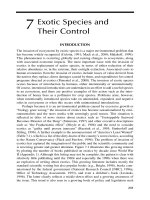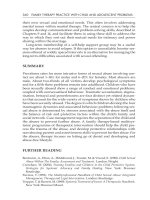Lecture Leadership - Theory and practice: Chapter 7 – Path-Goal theory
Bạn đang xem bản rút gọn của tài liệu. Xem và tải ngay bản đầy đủ của tài liệu tại đây (855.03 KB, 27 trang )
Chapter 7 - Path-Goal Theory
Leadership
Chapter 7 – Path-Goal Theory
Northouse, 4th edition
Chapter 7 - Path-Goal Theory
Overview
Path-Goal Theory Perspective
Conditions of Leadership Motivation
Leader Behaviors & Subordinate
Characteristics
Task Characteristics
How Does the PGT Approach Work?
Chapter 7 - Path-Goal Theory
Path-Goal Theory (House, 1971)
Description
Definition
Path-goal theory centers on how leaders
motivate subordinates to accomplish
designated goals
Emphasizes the relationship between
the leaders style
the characteristics of the subordinates
the work setting
Chapter 7 - Path-Goal Theory
Path-Goal Theory (House, 1971)
Description
Perspective
Goal - To enhance employee performance and
satisfaction by focusing on employee
motivation
Motivational Principles (based on Expectancy
Theory) - Subordinates will be motivated if they
believe:
– they are capable of performing their work
– that their efforts will result in a certain outcome
– that the payoffs for doing their work are worthwhile
Chapter 7 - Path-Goal Theory
Challenge to Leader
Use a Leadership Style that best meets
subordinates motivational needs
– choose behaviors that complement or
supplement what is missing in the work setting
– enhance goal attainment by providing
information or rewards
– provide subordinates with the elements they
need to reach their goals
Chapter 7 - Path-Goal Theory
Conditions of Leadership Motivation
Leadership generates motivation when:
It increases the number and kinds
of payoffs subordinates receive
from their work
Makes the path to the goal clear
and easy to travel through with
coaching and direction
Removes obstacles and
roadblocks to attaining the goal
Makes the work itself more
personally satisfying
Chapter 7 - Path-Goal Theory
Basic Idea
Chapter 7 - Path-Goal Theory
Path-Goal Theory
Chapter 7 - Path-Goal Theory
Major Components of Path-Goal Theory
Path-Goal Theory Suggests:
Each type of leader behavior has a
different kind of impact on
subordinates motivation
Whether or not a particular leader
behavior is motivating is contingent on
– subordinate characteristics
– task characteristics
Chapter 7 - Path-Goal Theory
Leader Behaviors
Directive Leadership
Leader who gives subordinates task
instruction including:
– What is expected of them
– How task is to be done
– Timeline for task completion
Leader – sets clear standards of performance
– makes rules & regulations clear to
subordinates
Chapter 7 - Path-Goal Theory
Leader Behaviors
Supportive Leadership
Refers to being friendly and approachable
as a leader and includes:
– Attending to well-being & human needs of
subordinates’
– Using supportive behavior to make work
environment pleasant
– Treating subordinates as equals & give them
respect for their status
Chapter 7 - Path-Goal Theory
Leader Behaviors
Participative Leadership
Leader who invites subordinates to share
in the decision-making
A participative leader:
– Consults with subordinates
– Seeks their ideas & opinions
– Integrates their input into
group/organizational decisions
Chapter 7 - Path-Goal Theory
Leader Behaviors
Achievement Oriented Leadership
Leader who challenges subordinates to
perform work at the highest level possible
An achievement oriented leader:
– Establishes a high standard of excellence for
subordinates
– Seeks continuous improvement
– Demonstrates a high degree of confidence in
subordinates’ ability to establish & achieve
challenging goals
Chapter 7 - Path-Goal Theory
Subordinate Characteristics
Determine how a leader’s behavior will
be interpreted by subordinates in a
given work context
Researchers focus on subordinates’
– Need for affiliation
– Preferences for structure (less uncertainty)
– Desires for control (Locus of Control)
– Self-perceived level of task ability
Chapter 7 - Path-Goal Theory
Subordinate Characteristics
Strong need for affiliation
– Friendly and concerned leadership is a source
of satisfaction
– Supportive Leadership
Preference for Structure
– Dogmatic & authoritarian
Leadership provides psychological structure, task
clarity & greater sense of certainty in work setting
– Directive Leadership
Chapter 7 - Path-Goal Theory
Subordinate Characteristics
Desire for Control
– Internal locus of control
Leadership that allows subordinates to feel in
charge of their work & makes them an integral part
of the decision-making process
Participative Leadership
– External locus of control
Leadership that parallels subordinates feelings that
outside forces control their circumstances
Directive Leadership
Chapter 7 - Path-Goal Theory
Subordinate Characteristics
Perception of their own ability –
specific task
– As perception of ability and competence
goes up need for highly directive
leadership goes down.
– Directive leadership may become
redundant – possibly excessively
controlling
Chapter 7 - Path-Goal Theory
Task Characteristics
Components
Task Characteristics:
– Design of subordinates’ task
– Organization’s formal authority system
– Primary work group of subordinates
Chapter 7 - Path-Goal Theory
Task Characteristics
Task Situations Requiring Leader Involvement
Unclear and ambiguous - Leader needs to
provide structure
Highly repetitive - Leader needs to provide
support to maintain subordinate motivation
Weak formal authority - If formal authority
system is weak, the leader needs to assist
subordinates by making rules and work
requirements clear
Nonsupportive/weak group norms - Leader
needs to help build cohesiveness and role
responsibility
Chapter 7 - Path-Goal Theory
Task Characteristics
Obstacles
Anything in the work setting that gets in the
way of subordinates
– They create excessive uncertainties, frustrations,
or threats for subordinates
Leaders responsibility is to help subordinates
by –
– Removing the obstacles
– Helping subordinates around them
Assisting with obstacles will increase
– Subordinates’ expectations to complete the task
– Their sense of job satisfaction
Chapter 7 - Path-Goal Theory
How Does the Path-Goal
Theory Approach Work?
Focus of Path-Goal Theory
Strengths
Criticisms
Application
Chapter 7 - Path-Goal Theory
How Does Path-Goal Theory Work?
The leader’s job is to help subordinates reach
their goals by directing, guiding, and coaching
them along the way
Leaders must evaluate task and subordinate
characteristics and adapt leadership style to these
The theory suggests which style is most
appropriate for specific characteristics
Chapter 7 - Path-Goal Theory
Path-Goal Theory Approach
Focus
Overall Scope
Path-goal theory is a
complex but also
pragmatic approach
Path-goal theory
provides a set of
assumptions about how
different leadership
Leaders should choose
styles will interact with
a leadership style that
subordinate
best fits the needs of
characteristics and the
subordinates and their
work situation to affect
work
employee motivation
Chapter 7 - Path-Goal Theory
Path-Goal Theory Matrix
Chapter 7 - Path-Goal Theory
Strengths
Useful theoretical framework. Path-goal theory is
a useful theoretical framework for understanding
how various leadership behaviors affect the
satisfaction of subordinates and their work
performance.
Integrates motivation. Path-goal theory attempts
to integrate the motivation principles of expectancy
theory into a theory of leadership.
Practical model. Path-goal theory provides a
practical model that underscores and highlights the
important ways leaders help subordinates.









